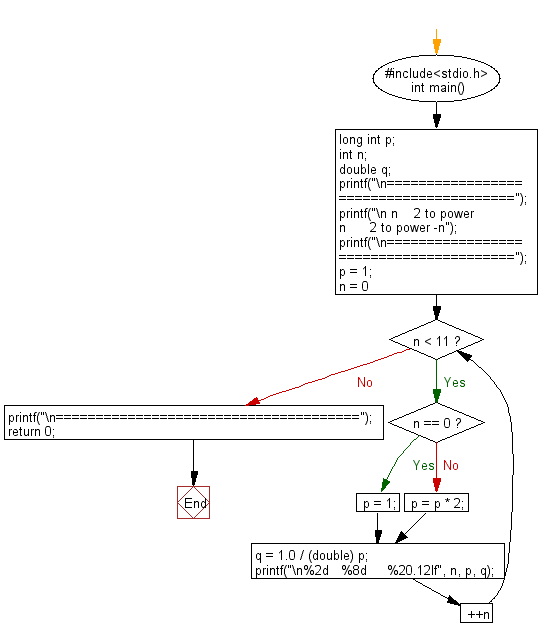C Exercises: Print the powers of 2 table for the power 0 to 10
C Basic Declarations and Expressions: Exercise-68 with Solution
Write a C program to print the powers of 2 table for the power 0 to 10, both positive and negative.
Sample Solution:
C Code:
#include<stdio.h>
int main() {
long int p;
int n;
double q;
printf("\n=======================================");
printf("\n n 2 to power n 2 to power -n");
printf("\n=======================================");
p = 1;
for (n = 0; n < 11; ++n) {
if (n == 0)
p = 1;
else
p = p * 2;
q = 1.0 / (double) p;
printf("\n%2d %8d %20.12lf", n, p, q);
}
printf("\n======================================");
return 0;
}
Sample Output:
======================================= n 2 to power n 2 to power -n ======================================= 0 1 1.000000000000 1 2 0.500000000000 2 4 0.250000000000 3 8 0.125000000000 4 16 0.062500000000 5 32 0.031250000000 6 64 0.015625000000 7 128 0.007812500000 8 256 0.003906250000 9 512 0.001953125000 10 1024 0.000976562500 ======================================
Flowchart:

C programming Code Editor:
Contribute your code and comments through Disqus.
Previous:Write a C program to evaluate the equation y=xn when n is a non-negative integer.
Next: Write a C program to print a binomial coefficient table.
What is the difficulty level of this exercise?
Test your Programming skills with w3resource's quiz.
C Programming: Tips of the Day
Static variable inside of a function in C
The scope of variable is where the variable name can be seen. Here, x is visible only inside function foo().
The lifetime of a variable is the period over which it exists. If x were defined without the keyword static, the lifetime would be from the entry into foo() to the return from foo(); so it would be re-initialized to 5 on every call.
The keyword static acts to extend the lifetime of a variable to the lifetime of the programme; e.g. initialization occurs once and once only and then the variable retains its value - whatever it has come to be - over all future calls to foo().
Ref : https://bit.ly/3fOq7XP
- New Content published on w3resource:
- HTML-CSS Practical: Exercises, Practice, Solution
- Java Regular Expression: Exercises, Practice, Solution
- Scala Programming Exercises, Practice, Solution
- Python Itertools exercises
- Python Numpy exercises
- Python GeoPy Package exercises
- Python Pandas exercises
- Python nltk exercises
- Python BeautifulSoup exercises
- Form Template
- Composer - PHP Package Manager
- PHPUnit - PHP Testing
- Laravel - PHP Framework
- Angular - JavaScript Framework
- Vue - JavaScript Framework
- Jest - JavaScript Testing Framework
